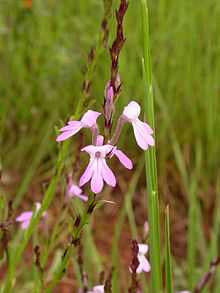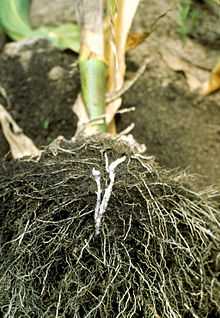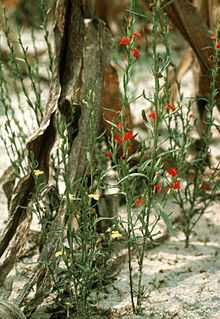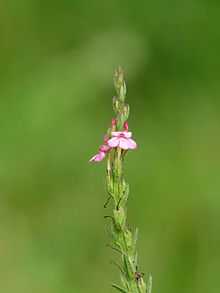Striga
| Striga | |
|---|---|
 | |
| Scientific classification | |
| Kingdom: | Plantae |
| (unranked): | Angiosperms |
| (unranked): | Eudicots |
| (unranked): | Asterids |
| Order: | Lamiales |
| Family: | Orobanchaceae |
| Genus: | Striga |
Striga, commonly known as witchweed or witches weed, is a genus of parasitic plants that occur naturally in parts of Africa, Asia, and Australia. It is in the family Orobanchaceae. Some species are serious pathogens of crop cereals, with the greatest effects being in savanna agriculture in Africa. It also causes considerable crop losses in other regions, including other tropical and subtropical crops in its native range and in the Americas.
Description
Witchweeds are characterized by bright-green stems and leaves and small, brightly colored and attractive flowers.[1] They are obligate hemiparasites of roots and require a living host for germination and initial development, though they can then survive on their own.[2]
The genus is classified in the family Orobanchaceae,[3] although older classifications place it in the Scrophulariaceae.[4]
The number of species is not certain, but exceeds 40 by some counts.[2][5]
Hosts and symptoms
Although most species of Striga are not pathogens that affect human agriculture, some species have devastating effects upon crops, particularly those planted by subsistence farmers.[6] Crops most commonly affected are corn, sorghum, rice and sugarcane.[1][7] Three species cause the most damage: Striga asiatica, S. gesnerioides, and S. hermonthica.
Witchweed parasitizes maize, millet, sorghum, sugarcane, rice, legumes, and a range of weedy grasses.[8] It is capable of significantly reducing yields, in some cases wiping out the entire crop.[1]
Host plant symptoms, such as stunting, wilting, and chlorosis, are similar to those seen from severe drought damage, nutrient deficiency, and vascular disease.[1][8][9]
Lifecycle

Each plant is capable of producing up to 500,000 seeds, which may remain viable in the soil for over 10 years.[10] An annual plant, witchweed overwinters in the seed stage.[1] Its seeds germinate in the presence of host root exudate, and develop haustoria which penetrate host root cells.[1] Host root exudate contain strigolactones, signaling molecules that promote striga seed germination.[11] A bell-like swell forms where the parasitic roots attach to the roots of the host.[8] The pathogen colonizes underground, where it may spend the next four to seven weeks before emergence, when it rapidly flowers and produces seeds.[8] Witchweed seeds spread easily by wind, water, and soil via animal vectors.[8] The chief means of dispersal, however, is through human interaction, by means of machinery, tools, and clothing.[8][10]
Haustorium Development
Once germination is stimulated, the Striga seed sends out an initial root to probe the soil for the host root. The initial root secretes an oxidizing enzyme that digests the host root surface, releasing quinones.[12] If the quinone product is within the appropriate concentrations, a haustorium will develop from the initial root. The haustorium grows toward the host root until it makes contact with the root surface, establishing parasitic contact in relatively short order. Within 12 hours of initial haustorium growth, the haustorium recognizes the host root and begins rapid cell division and elongation.[13] The haustorium forms a wedge shape and uses mechanical force and chemical digestion to penetrate the host root, pushing the host cells out of the way.[13][14] Within 48–72 hours, the haustorium has penetrated the host root cortex.[13] Finger-like structures on the haustorium, called osculum, penetrate the host xylem through pits in the membrane.[14] The osculum then swell to secure their position within the xylem membrane. Striga sieve tubes develop along with the osculum. Shortly after the host xylem is penetrated, Striga sieve tubes develop and approach the host phloem within eight cells.[15][16] This eight cell layer allows for nonspecific nutrient transport from the host to the Striga seedling.[15][16] Within 24 hours after tapping the host xylem and phloem, the Striga cotyledons emerge from the seed.[13]
Environment
Temperatures ranging from 30 to 35 °C (86 to 95 °F) in a moist environment are ideal for germination.[8] Witchweed will not develop in temperatures below 20 °C (68 °F). Agricultural land with light soil and low nitrogen levels tend to favor its development.[17] Still, witchweed has demonstrated a wide tolerance for soil types if soil temperatures are favorably high.[1] Seeds have been shown to survive in frozen soil of temperatures as low as −15 °C (5 °F), attesting to their aptitude as overwintering structures.[1]
Soil temperature, air temperature, photoperiod, soil type, and soil nutrient and moisture levels do not greatly deter the development of witchweed.[1] These findings suggest, though it has been limited to the Carolinas in the United States, that the pathogen would successfully infect the massive corn crops of the Midwest.[1]
Management
Management of witchweed is difficult because the majority of its life cycle takes place below ground. If it is not detected before emergence, it is too late to reduce crop loss.[8] To prevent witchweed from spreading it is necessary to plant uncontaminated seeds and clean soil and plant debris off of machinery, shoes, clothing, and tools before entering fields.[8][17] If populations are low, hand weeding before seeds are produced is an option.
Striga in the United States has been controlled through the use of several management strategies, including quarantines imposed on affected areas, control of movement of farm equipment between infected and uninfected areas, herbicide application, and imposed "suicidal germination". For the latter, in fields not yet planted in crops, seeds present in the soil are induced to germinate by injecting ethylene gas, which mimics the natural physiological response tied to host recognition. Because no host roots are available, the seedlings die. Unfortunately, each Striga plant can produce tens of thousands of tiny seeds, which can remain dormant in the soil for many years.[18] Thus, such treatments do not remove all seeds from the soil. Moreover, this method is expensive and not generally available to many farmers in developing nations of Africa and Asia.
Another method called trap cropping involves planting a species in an infested field that will induce the Striga seeds to germinate but will not support attachment of the parasite. This method has been used in sorghum plantations by planting Celosia argentea between the sorghum.[19] Planting silverleaf (Desmodium uncinatum) inhibits striga seed germination and has worked effectively intercropped with maize.[20][21] Cotton, sunflower, linseed, and witchweed-resistant maize are also effective trap crops.[8]
Increasing nitrogen levels in the soil, growing tolerant varieties,and trap-cropping, and planting susceptible crops harvested before witchweed seed is produced, can also be used.[17] Coating maize seeds with fungi or a herbicide also appears to be a promising approach.
Several sorghum varieties have high levels of resistance in local conditions, including 'N-13', 'Framida', and 'Serena'.[22][23] 'Buruma', 'Shibe', 'Okoa' and 'Serere 17' millet cultivars are considered to be resistant in Tanzania.[23] Some corn varieties show partial resistance to witchweed, including 'Katumani' in Kenya.[23] In a number of rice cultivars, including some cultivars of NERICA (New Rice for Africa), effective pre- and post- attachment resistance mechanisms have been identified.[24][25] Some crop cultivars, especially corn, are resistant to herbicides that kill witchweed when the haustoria attach to the crop.[26] 'Strigaway' maize has been shown to reduce the seed bank of striga by 30% in two seasons.[26]
Importance
Maize, sorghum, and sugarcane crops affected by witchweed in the United States have an estimated value well over $20 billion.[1] Furthermore, witchweed is capable of wiping out an entire crop.[8] In fact, it is so prolific that in 1957 Congress allocated money in an attempt to eradicate witchweed. Thus, the Animal and Plant Health Inspection Service (APHIS) of the U.S. Department of Agriculture established a research station and control methods.[10] Through infestation mapping, quarantine, and control activities such as contaminated seed destruction, the acreage parasitized by witchweed has been reduced 99% since its discovery in the United States.[10] APHIS has even offered cash rewards for those identify and report the weed, and encourages landowners to check their own acreage.[10]
Parasitizing important economic plants, witchweed is one of the most destructive pathogens in Africa.[9] In fact, witchweed affects 40% of Africa’s arable savanna region, resulting in up to $13 billion lost every year.[23] Striga affects 40 million hectares (98,842,153 acres) of crops in sub-Saharan Africa alone.[26] The witchweed infestation is so bad in parts of Africa, some farmers have to relocate every few years.[27] Furthermore, the majority of crops in Africa are grown by subsistence farmers who cannot afford expensive witchweed controls, who therefore suffer much as a result of this pathogen.[27]
Common species


- Striga asiatica has a very wide geographic distribution, from Africa through southern and eastern Asia to Australia. Since the 1950s, it is also known from the United States. This introduction, likely a result of human activity, resulted in an infestation of corn (maize) across many counties in North and South Carolina. The United States Department of Agriculture and state agencies imposed a quarantine on this area to control its spread - a process that was apparently successful.
- Striga hermonthica (purple witchweed) is also a parasite that affects grasses, particularly sorghum and pearl millet in sub-Saharan Africa (Senegal to Ethiopia, Democratic Republic of Congo and Tanzania, Angola, Namibia).
- Cowpea witchweed, as its name implies, is a parasite of cowpea (Vigna unguiculata), which is not a grass, but a member of the legume family (Fabaceae or Leguminosae). This species was also accidentally introduced into Florida in the United States, where it was found parasitizing Indigofera hirsuta (hairy indigo, another legume).
- Striga aequinoctialis West Africa
- Striga angolensis Angola
- Striga angustifolia East Africa, Asia, Indonesia
- Striga asiatica (Asiatic witchweed) Africa, Arabian peninsula, India, Burma, China, Indonesia, the Philippines, Malaysia, New Guinea, Australia (introduced?), USA (introduced)
- Striga aspera Africa
- Striga bilabiata Africa
- Striga brachycalyx Africa.
- Striga chrysantha Central Africa
- Striga dalzielii West Africa
- Striga elegans Angola, Malawi, South Africa, Zimbabwe
- Striga forbesii Africa, Madagascar
- Striga gastonii Chad, Central African Republic
- Striga gesnerioides (cowpea witchweed) Africa, Arabian peninsula, India, USA (introduced)
- Striga gracillima Tanzania
- Striga hallaei Gabon, Democratic Republic of Congo
- Striga hirsuta Madagascar
- Striga indica India
- Striga junodii South Africa, Mozambique
- Striga klingii West Africa, Nigeria, Ghana, Cameroon, Togo
- Striga latericea East Africa, Ethiopia, Somalia
- Striga lepidagathidis Senegal, Guinea, Guinea Bissau
- Striga lutea Sudan, Ethiopia
- Striga macrantha West Africa, Nigeria, Ivory Coast, Togo
- Striga passargei West and Central Africa, Arabian peninsula
- Striga pinnatifida Ethiopia
- Striga primuloides Ivory Coast, Nigeria
- Striga pubiflora Somalia
- Striga yemenica Ethiopia
Gallery
-
_in_Hyderabad%2C_AP_W_IMG_9828.jpg)
Striga densiflora in Hyderabad, India
-
_in_Hyderabad%2C_AP_W_IMG_9826.jpg)
Striga densiflora in Hyderabad
-
_in_Hyderabad%2C_AP_W_IMG_9825.jpg)
Striga densiflora in Hyderabad
See also
- Push–pull technology
Sources
- ↑ 1.0 1.1 1.2 1.3 1.4 1.5 1.6 1.7 1.8 1.9 1.10 Sand, Paul, Robert Eplee, and Randy Westbrooks.Witchweed Research and Control in the United States. Champaign, IL: Weed Science Society of America, 1990.
- ↑ 2.0 2.1 Witchweeds - beautiful but deadly, in The Horticulturalist, Vol. 21-4, October 2012
- ↑ Young, Nelson D.; Steiner, Kim E.; dePamphilis, Claude W. (Autumn 1999). "The Evolution of Parasitism in Scrophulariaceae/Orobanchaceae: Plastid Gene Sequences Refute an Evolutionary Transition Series". Annals of the Missouri Botanical Garden 86 (4): 876–93. doi:10.2307/2666173. JSTOR 2666173.
- ↑ For example, Integrated Taxonomic Information System as of 16 Sep 2007
- ↑ Mohamed, Kamal I.; Musselman, Lytton John; Riches, Charles R. (Winter 2001). "The Genus Striga (Scrophulariaceae) in Africa". Annals of the Missouri Botanical Garden 88 (1): 60–103. doi:10.2307/2666132. JSTOR 2666132.
- ↑ Nickrent, D. L.; Musselman, L. J. (2004). "Introduction to Parasitic Flowering Plants". The Plant Health Instructor. doi:10.1094/PHI-I-2004-0330-01.
- ↑ Rodenburg, Jonne; Riches, Charles R.; Kayeke, Juma M. (2010). "Addressing current and future problems of parasitic weeds in rice". Crop Protection 29 (3): 210. doi:10.1016/j.cropro.2009.10.015.
- ↑ 8.0 8.1 8.2 8.3 8.4 8.5 8.6 8.7 8.8 8.9 8.10 Johnson, Annie. New South Wales. Witchweed. 2005. http://www.wyong.nsw.gov.au/environment/Weeds_category_one_Witchweed.pdf
- ↑ 9.0 9.1 Agrios, George N. Plant Pathology. 5th ed. London: Elsevier Academic Press, 2005.
- ↑ 10.0 10.1 10.2 10.3 10.4 United States. Witchweed: A Parasitic Pest. District of Columbia: USDA, 2003. http://www.aphis.usda.gov/publications/plant_health/content/printable_version/fs_phwitchweed.pdf[]
- ↑ Matusova, Radoslava; Rani, Kumkum; Verstappen, Francel W.A.; Franssen, Maurice C.R.; Beale, Michael H.; Bouwmeester, Harro J. (2005). "The Strigolactone Germination Stimulants of the Plant-Parasitic Striga and Orobanche spp. Are Derived from the Carotenoid Pathway". Plant Physiology 139 (2): 920–34. doi:10.1104/pp.105.061382. PMC 1256006. PMID 16183851.
- ↑ Chang, M (1986). "The haustorium and the chemistry of host recognition in parasitic angiosperms". Journal of Chemical Ecology.
- ↑ 13.0 13.1 13.2 13.3 Hood, M.E. (1997). "Primary haustorial development and Striga asiatica on host and nonhost species". The American Phytopathological Society.
- ↑ 14.0 14.1 Dorr, Inge (1996). "How Striga parasitizes its host: a TEM and SEM study". Annals of Botany.
- ↑ 15.0 15.1 Sieve elements: comparative structure, induction, and development. Springer-Verlag Berline Heidelberg. 1990. pp. 239–256.
- ↑ 16.0 16.1 Dorr, Inge (1995). "Symplastic sieve element continuity between Orobanche and its host". Botanica Acta.
- ↑ 17.0 17.1 17.2 California Department of Food and Agriculture. Witchweed. http://www.cdfa.ca.gov/phpps/ipc/weedinfo/striga.htm
- ↑ van Mourik, Thomas A (2007). Striga hermonthica seed bank dynamics process quantification and modelling (PhD thesis). Wageningen University. ISBN 978-90-8504-692-9.
- ↑ Olupot, J.R; Osiru, D.S.O; Oryokot, J; Gebrekidan, B (2003). "The effectiveness of Celosia argentia (Striga 'chaser') to control Striga on Sorghum in Uganda". Crop Protection 22 (3): 463–8. doi:10.1016/S0261-2194(02)00181-3.
- ↑ Khan, Zeyaur R.; Hassanali, Ahmed; Overholt, William; Khamis, Tsanuo M.; Hooper, Antony M.; Pickett, John A.; Wadhams, Lester J.; Woodcock, Christine M. (2002). "Control of witchweed Striga hermonthica by intercropping with Desmodium spp., and the mechanism defined as allelopathic". Journal of Chemical Ecology 28 (9): 1871–85. doi:10.1023/A:1020525521180. PMID 12449513.
- ↑ Radford, Tim (September 18, 2003). "Perfect maize, in three simple steps". The Guardian (London). Retrieved May 24, 2010.
- ↑ Rodenburg, J.; Bastiaans, L.; Weltzien, E.; Hess, D.E. (2005). "How can field selection for Striga resistance and tolerance in sorghum be improved?". Field Crops Research 93 (1): 34–50. doi:10.1016/j.fcr.2004.09.004.
- ↑ 23.0 23.1 23.2 23.3 "Purple Witchweed." Infonet-biovision. N.p., 14 Sep 2009. Web. 7 Dec 2010. <http://www.infonet-biovision.org/default/ct/112/pests>.
- ↑ Jamil, Muhammad; Rodenburg, Jonne; Charnikhova, Tatsiana; Bouwmeester, Harro J. (2011). "Pre-attachment Striga hermonthica resistance of New Rice for Africa (NERICA) cultivars based on low strigolactone production". New Phytologist 192 (4): 964–75. doi:10.1111/j.1469-8137.2011.03850.x. PMID 21883233.
- ↑ Cissoko, Mamadou; Boisnard, Arnaud; Rodenburg, Jonne; Press, Malcolm C.; Scholes, Julie D. (2011). "New Rice for Africa (NERICA) cultivars exhibit different levels of post-attachment resistance against the parasitic weeds Striga hermonthica and Striga asiatica". New Phytologist 192 (4): 952–63. doi:10.1111/j.1469-8137.2011.03846.x. PMID 21883232.
- ↑ 26.0 26.1 26.2 "Controlling Witchweed in Sub-saharan Africa." Web. 7 Dec 2010. <http://www.aatf-africa.org/UserFiles/File/Controlling%20witchweed%20in%20SSA_AATF_Annual-Report_2005.pdf>
- ↑ 27.0 27.1 Samarrai, Fariss. "U.Va. Scientists Identify Gene for Resistance to Parasitic 'Witchweed'." UVaToday. N.p., 27 Aug 2009. Web. 7 Dec 2010. <http://www.virginia.edu/uvatoday/newsRelease.php?id=9543>
Further reading
- Clark, Lawrence J.; Shawe, Keith G.; Hoffmann, Gŕrard; Stewart, George R. (1994). "The effect ofStriga hermonthica(Del.) Benth. Infection on gas-exchange characteristics and yield of a sorghum host, measured in the field in Mali". Journal of Experimental Botany 45 (2): 281–3. doi:10.1093/jxb/45.2.281.
- Gérard, Hoffmann; Loisel, Roger (1994). Contribution à l'étude des Phanérogames parasites du Burkina Faso et du Mali: quelques aspects de leur écologie, biologie et techniques de lutte [Contribution to the study of parasitic Phanerogams of Burkina Faso and Mali: some aspects of their ecology, biology and control technics] (PhD Thesis) (in French). OCLC 489977820. INIST:163863.
- Gérard, Hoffmann; Diarra, C; Dembele, D (1994). "Outbreaks and new records: Striga asiatica, new pest of maize in Mali". FAO (Food and Agriculture Organization of the United Nations) Plant Protection Bulletin 42 (42): 214–5.
- Gérard, Hoffmann; Marnotte, P.; Dembélé, D (1997). "Emploi d'herbicides pour lutter contre Striga hermonthica : Striga" [The use of herbicides to control Striga hermonthica]. Agriculture et Développement (in French) 13: 58–62. INIST:2781044.
- Khan, Zeyaur R.; Hassanali, Ahmed; Overholt, William; Khamis, Tsanuo M.; Hooper, Antony M.; Pickett, John A.; Wadhams, Lester J.; Woodcock, Christine M. (2002). "Control of witchweed Striga hermonthica by intercropping with Desmodium spp., and the mechanism defined as allelopathic". Journal of Chemical Ecology 28 (9): 1871–85. doi:10.1023/A:1020525521180. PMID 12449513.
- Khan, Zeyaur R.; Midega, Charles A. O.; Hassanali, Ahmed; Pickett, John A.; Wadhams, Lester J. (2007). "Assessment of Different Legumes for the Control of in Maize and Sorghum". Crop Science 47 (2): 730–4. doi:10.2135/cropsci2006.07.0487.
- Moore, T. H. M.; Lane, J. A.; Child, D. V.; Arnold, G. M.; Bailey, J. A.; Hoffmann, G. (1995). "New sources of resistance of cowpea (Vigna unguiculata) toStriga gesnerioides, a parasitic angiosperm". Euphytica 84 (3): 165–74. doi:10.1007/BF01681808.
External links
- The Parasitic Plant Connection: Striga Photo Gallery
- The Parasitic Plant Connection: Striga asiatica in the USA
- Witchweed
- UN Development Programme
- Striga research at the International Institute of Tropical Agriculture (IITA)
- Parasitic Plants as Weeds
- Striga weed control with herbicide-coated maize seed, CIMMYT
- A recipe for Striga control in sub-saharan Africa
- Moore, T. H. M.; Lane, J. A.; Child, D. V.; Arnold, G. M.; Bailey, J. A.; Hoffmann, G. (1995). "New sources of resistance of cowpea (Vigna unguiculata) toStriga gesnerioides, a parasitic angiosperm". Euphytica 84 (3): 165–74. doi:10.1007/BF01681808.
- Facebook community page "Striga Research and Control"